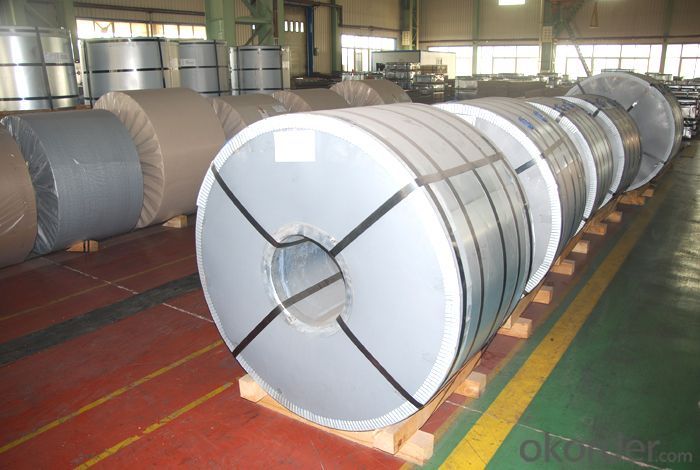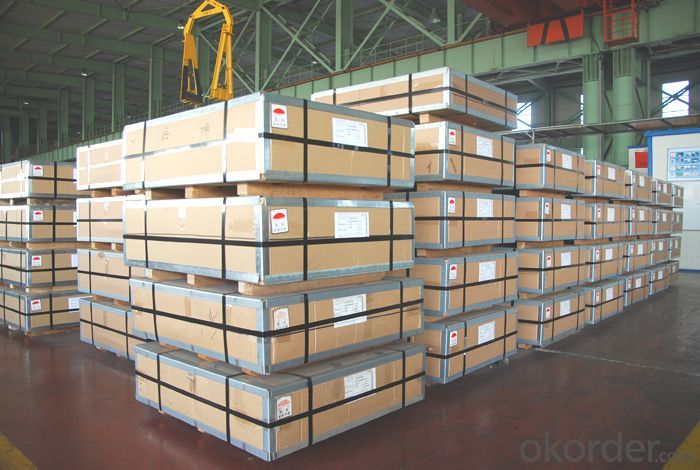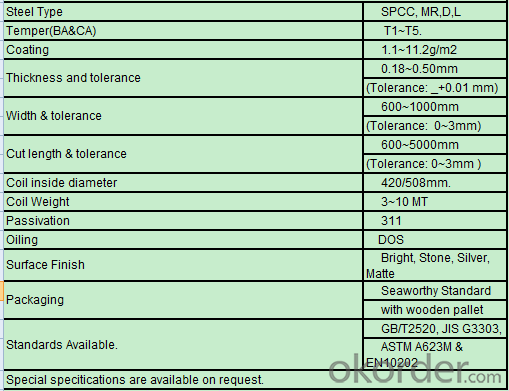Tin Plate / Electrolytic Tinplate / ETP for Tin Cans Containers
- Loading Port:
- Tianjin
- Payment Terms:
- TT OR LC
- Min Order Qty:
- 100 m.t.
- Supply Capability:
- 40000 m.t./month
OKorder Service Pledge
OKorder Financial Service
You Might Also Like
Item specifice
Structure of Tin Plate / Electrolytic Tinplate / ETP for Tin Cans Containers Description
| Steel Type | MR | ||
| Temper(BA&CA) | T1~T5, DR8, DR9 | ||
| Coating | 1.1~11.2g/m2 (Both Equal and Differential) | ||
| Thickness and tolerance | 0.15~0.50mm(Tolerance: _+0.01 mm) | ||
| Width & tolerance | 300~1000mm (Tolerance: 0~3mm) | ||
| Cut length & tolerance | 450~``50mm (Tolerance: 0~3mm ) | ||
| Coil inside diameter | 420/508mm | ||
| Coil Weight | 3~10 MT | ||
| Passivation | 311 | ||
| Oiling | DOS | ||
| Surface Finish | Bright, Stone, Silver, Matte | ||
| Packaging | Seaworthy Standard with wooden pallet | ||
| Standards Available | GB/T2520, JIS G3303, ASTM A623M & EN10202 | ||
| Special specitications are available on request. | |||
Tin Plate / Electrolytic Tinplate / ETP for Tin Cans Containers China
Tinplate can ensure food hygiene and minimize the possibility of corruption, effectively
prevent the danger to health, but also in line with modern convenience in tinplate packaging
of canned food diet, rapid demand, tea packaging, coffee packaging, health careproduct
packaging, candy wrappers, cigarette packaging, gift packaging, food packaging containers
are preferred.As well as other miscellaneous cans of the oils and fats cans, chemicals
cans, beverage cans, spray cans, and and so on on.
Tin Plate / Electrolytic Tinplate / ETP for Tin Cans Containers Images



Tin Plate / Electrolytic Tinplate / ETP for Tin Cans Containers Specification

FAQ of Tin Plate / Electrolytic Tinplate / ETP for Tin Cans Containers
How long does it take to get the product if i place an order?
With the process of your requirements,we will pack and deliver in 3-7 days.If it is by sea shipment,it will take 15-45 days depending on different locations.
- Q:What are the main applications of tinplate in the furniture industry?
- Tinplate is commonly used in the furniture industry for various applications such as decorative accents, hardware components, and protective coatings. It is used to create intricate designs on furniture pieces, add a glossy finish to metal parts, and provide a layer of protection against corrosion and rust. Additionally, tinplate can be utilized for embossing or stamping logos and patterns on furniture items, enhancing their visual appeal.
- Q:How does tinplate packaging contribute to product marketing?
- Tinplate packaging contributes to product marketing in several ways. Firstly, it enhances the visual appeal of the product, making it more attractive to potential customers. The shiny and vibrant nature of tinplate packaging can catch consumers' attention and create a positive first impression. Additionally, tinplate packaging can be customized with high-quality printing, allowing for brand logos, product information, and eye-catching designs to be prominently displayed. This helps build brand recognition and reinforces brand image. Moreover, tinplate packaging provides durability and protection, ensuring that the product remains in good condition during transportation and on store shelves. This reliability can instill trust in consumers and enhance the perceived value of the product. Overall, tinplate packaging plays a crucial role in differentiating products from competitors and influencing purchasing decisions through its visual appeal, branding opportunities, and protective qualities.
- Q:What are the different ways to customize tinplate packaging?
- There are several ways to customize tinplate packaging. These include printing the packaging with custom designs, adding embossing or debossing for texture, applying special finishes like glossy or matte coatings, incorporating special effects like metallic or holographic foils, and using different colors or patterns. Additionally, custom shapes and sizes can be created to suit specific product requirements.
- Q:What are the factors that determine the lifespan of tinplate packaging?
- The factors that determine the lifespan of tinplate packaging include the quality of the tinplate material used, the manufacturing process, the storage and handling conditions, and the level of protection provided against external factors such as moisture, temperature, and physical damage.
- Q:What are the common applications of tinplate?
- Tinplate is commonly used for packaging food and beverages, such as cans for canned goods, metal caps for bottles, and metal containers for various products. It is also used for making aerosol cans, paint cans, and decorative tin boxes for storage purposes. Additionally, tinplate is used in the manufacturing of electronic components, automotive parts, and construction materials due to its corrosion resistance and durability.
- Q:How does tinplate packaging handle exposure to different chemicals?
- Tinplate packaging is known for its excellent resistance to various chemicals. It can handle exposure to different chemicals without any significant adverse effects, making it a reliable choice for packaging materials.
- Q:How is tinplate affected by exposure to moisture?
- Tinplate is highly susceptible to corrosion when exposed to moisture. The presence of water causes the tin layer to oxidize, leading to the formation of tin oxide and compromising the protective barrier it provides. This can result in the degradation of the underlying steel base, leading to rusting and a reduction in the overall quality and durability of tinplate.
- Q:What are the main applications of tinplate in the cosmetics industry?
- Tinplate is extensively used in the cosmetics industry for packaging purposes. It is commonly employed for manufacturing containers such as cans, jars, and tubes for various cosmetic products like creams, powders, lip balms, and hair care products. Tinplate provides excellent protection against moisture, light, and other external factors, ensuring the longevity and quality of the cosmetic products. Additionally, its malleability allows for intricate designs and attractive branding possibilities, making it a popular choice in the cosmetics industry.
- Q:How does tinplate contribute to the safety and integrity of packaged products?
- Tinplate contributes to the safety and integrity of packaged products in several ways. Firstly, tinplate is highly resistant to corrosion, protecting the packaged products from exposure to moisture and other potentially harmful elements. This corrosion resistance ensures that the packaging remains intact, preventing any leakage or contamination of the product. Additionally, tinplate has excellent barrier properties, which means it effectively blocks out oxygen, light, and other external factors that could cause spoilage or degradation of the packaged goods. Furthermore, tinplate provides a strong and sturdy structure for packaging, ensuring that it can withstand transportation and handling without compromising the integrity of the product. Overall, tinplate's properties make it a reliable and protective material for packaging, thereby contributing to the safety and preservation of packaged products.
- Q:How is tinplate manufactured?
- Tinplate is manufactured through a process called electroplating, where a thin layer of tin is applied onto a base metal, usually steel. The steel is first cleaned and then immersed into an electrolyte solution containing tin ions. An electric current is then passed through the solution, causing tin ions to be attracted and deposited onto the steel surface, forming a layer of tin. This tin coating provides the steel with corrosion resistance and enhances its appearance, making it suitable for various applications such as food and beverage packaging.
1. Manufacturer Overview |
|
|---|---|
| Location | |
| Year Established | |
| Annual Output Value | |
| Main Markets | |
| Company Certifications | |
2. Manufacturer Certificates |
|
|---|---|
| a) Certification Name | |
| Range | |
| Reference | |
| Validity Period | |
3. Manufacturer Capability |
|
|---|---|
| a)Trade Capacity | |
| Nearest Port | |
| Export Percentage | |
| No.of Employees in Trade Department | |
| Language Spoken: | |
| b)Factory Information | |
| Factory Size: | |
| No. of Production Lines | |
| Contract Manufacturing | |
| Product Price Range | |
Send your message to us
Tin Plate / Electrolytic Tinplate / ETP for Tin Cans Containers
- Loading Port:
- Tianjin
- Payment Terms:
- TT OR LC
- Min Order Qty:
- 100 m.t.
- Supply Capability:
- 40000 m.t./month
OKorder Service Pledge
OKorder Financial Service
Similar products
New products
Hot products
Hot Searches
Related keywords


























